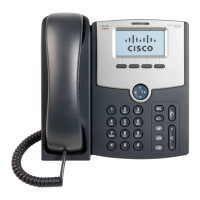4
Cisco SPA 500 Series and WIP310 IP Phone Administration Guide 78
Configuring SIP, SPCP, and NAT
The Cisco SPA 500 Series and Wireless IP Phones use the following protocols:
• Session Initiation Protocol (SIP)—Cisco SPA 500 Series, WIP310
• Cisco Smart Phone Control Protocol (SPCP)—Cisco SPA 500 Series
This chapter describes how to configure the phone protocols and other
parameters. It contains the following sections:
• Session Initiation Protocol and Cisco IP Phones, page 78
• Configuring SIP, page 81
• Configuring SPCP on the Cisco SPA 525G, page 101
• Configuring SPCP on the Cisco SPA 50XG, page 102
• Network Address Translation (NAT) and Cisco IP Phones, page 102
Session Initiation Protocol and Cisco IP Phones
Cisco IP phones use Session Initiation Protocol (SIP), allowing interoperation with
all ITSPs supporting SIP.
SIP handles signaling and session management within a packet telephony
network.
Signaling
allows call information to be carried across network
boundaries.
Session management
controls the attributes of an end-to-end call.
The following diagram shows a SIP request for connection to another subscriber
in the network.
In typical commercial IP telephony deployments, all calls go through a SIP proxy
server. The requesting phone is called the SIP user agent server (UAS), while the
receiving phone is called the user agent client (UAC).

